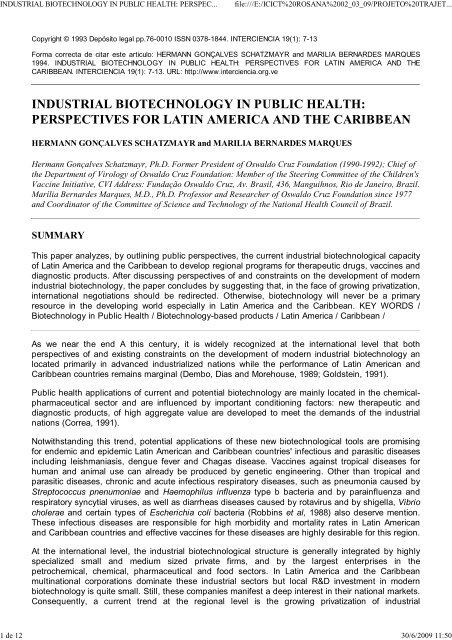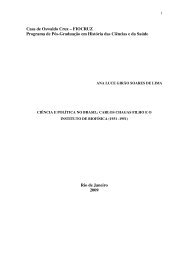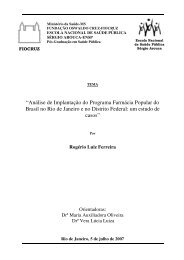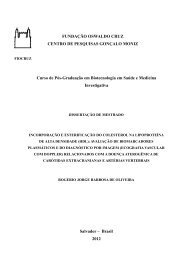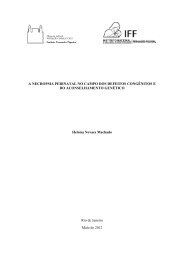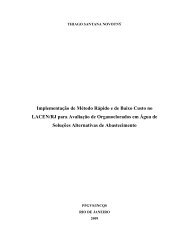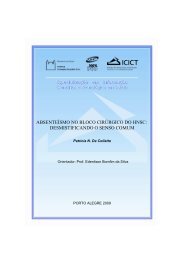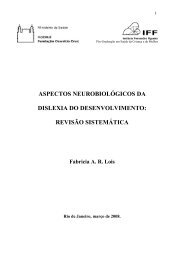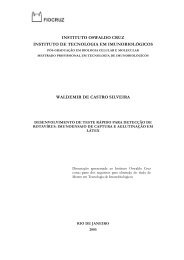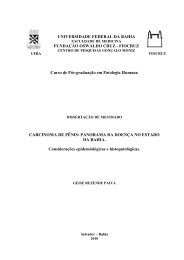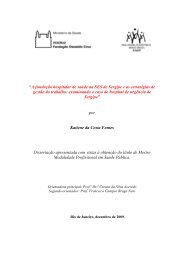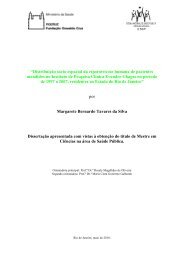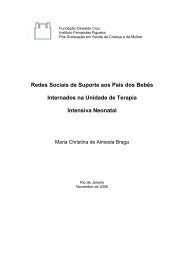industrial biotechnology in public health - Arca - Fiocruz
industrial biotechnology in public health - Arca - Fiocruz
industrial biotechnology in public health - Arca - Fiocruz
You also want an ePaper? Increase the reach of your titles
YUMPU automatically turns print PDFs into web optimized ePapers that Google loves.
INDUSTRIAL BIOTECHNOLOGY IN PUBLIC HEALTH: PERSPEC... file:///E:/ICICT%20ROSANA%2002_03_09/PROJETO%20TRAJET...<br />
Copyright © 1993 Depósito legal pp.76-0010 ISSN 0378-1844. INTERCIENCIA 19(1): 7-13<br />
Forma correcta de citar este articulo: HERMANN GONÇALVES SCHATZMAYR and MARILIA BERNARDES MARQUES<br />
1994. INDUSTRIAL BIOTECHNOLOGY IN PUBLIC HEALTH: PERSPECTIVES FOR LATIN AMERICA AND THE<br />
CARIBBEAN. INTERCIENCIA 19(1): 7-13. URL: http://www.<strong>in</strong>terciencia.org.ve<br />
INDUSTRIAL BIOTECHNOLOGY IN PUBLIC HEALTH:<br />
PERSPECTIVES FOR LATIN AMERICA AND THE CARIBBEAN<br />
HERMANN GONÇALVES SCHATZMAYR and MARILIA BERNARDES MARQUES<br />
Hermann Gonçalves Schatzmayr, Ph.D. Former President of Oswaldo Cruz Foundation (1990-1992); Chief of<br />
the Department of Virology of Oswaldo Cruz Foundation: Member of the Steer<strong>in</strong>g Committee of the Children's<br />
Vacc<strong>in</strong>e Initiative, CVI Address: Fundação Oswaldo Cruz, Av. Brasil, 436, Manguihnos, Rio de Janeiro, Brazil.<br />
Marília Bernardes Marques, M.D., Ph.D. Professor and Researcher of Oswaldo Cruz Foundation s<strong>in</strong>ce 1977<br />
and Coord<strong>in</strong>ator of the Committee of Science and Technology of the National Health Council of Brazil.<br />
SUMMARY<br />
This paper analyzes, by outl<strong>in</strong><strong>in</strong>g <strong>public</strong> perspectives, the current <strong><strong>in</strong>dustrial</strong> biotechnological capacity<br />
of Lat<strong>in</strong> America and the Caribbean to develop regional programs for therapeutic drugs, vacc<strong>in</strong>es and<br />
diagnostic products. After discuss<strong>in</strong>g perspectives of and constra<strong>in</strong>ts on the development of modern<br />
<strong><strong>in</strong>dustrial</strong> <strong>biotechnology</strong>, the paper concludes by suggest<strong>in</strong>g that, <strong>in</strong> the face of grow<strong>in</strong>g privatization,<br />
<strong>in</strong>ternational negotiations should be redirected. Otherwise, <strong>biotechnology</strong> will never be a primary<br />
resource <strong>in</strong> the develop<strong>in</strong>g world especially <strong>in</strong> Lat<strong>in</strong> America and the Caribbean. KEY WORDS /<br />
Biotechnology <strong>in</strong> Public Health / Biotechnology-based products / Lat<strong>in</strong> America / Caribbean /<br />
As we near the end A this century, it is widely recognized at the <strong>in</strong>ternational level that both<br />
perspectives of and exist<strong>in</strong>g constra<strong>in</strong>ts on the development of modern <strong><strong>in</strong>dustrial</strong> <strong>biotechnology</strong> an<br />
located primarily <strong>in</strong> advanced <strong><strong>in</strong>dustrial</strong>ized nations while the performance of Lat<strong>in</strong> American and<br />
Caribbean countries rema<strong>in</strong>s marg<strong>in</strong>al (Dembo, Dias and Morehouse, 1989; Goldste<strong>in</strong>, 1991).<br />
Public <strong>health</strong> applications of current and potential <strong>biotechnology</strong> are ma<strong>in</strong>ly located <strong>in</strong> the chemicalpharmaceutical<br />
sector and are <strong>in</strong>fluenced by important condition<strong>in</strong>g factors: new therapeutic and<br />
diagnostic products, of high aggregate value are developed to meet the demands of the <strong><strong>in</strong>dustrial</strong><br />
nations (Correa, 1991).<br />
Notwithstand<strong>in</strong>g this trend, potential applications of these new biotechnological tools are promis<strong>in</strong>g<br />
for endemic and epidemic Lat<strong>in</strong> American and Caribbean countries' <strong>in</strong>fectious and parasitic diseases<br />
<strong>in</strong>clud<strong>in</strong>g leishmaniasis, dengue fever and Chagas disease. Vacc<strong>in</strong>es aga<strong>in</strong>st tropical diseases for<br />
human and animal use can already be produced by genetic eng<strong>in</strong>eer<strong>in</strong>g. Other than tropical and<br />
parasitic diseases, chronic and acute <strong>in</strong>fectious respiratory diseases, such as pneumonia caused by<br />
Streptococcus pnenumoniae and Haemophilus <strong>in</strong>fluenza type b bacteria and by para<strong>in</strong>fluenza and<br />
respiratory syncytial viruses, as well as diarrheas diseases caused by rotavirus and by shigella, Vibrio<br />
cholerae and certa<strong>in</strong> types of Escherichia coli bacteria (Robb<strong>in</strong>s et al, 1988) also deserve mention.<br />
These <strong>in</strong>fectious diseases are responsible for high morbidity and mortality rates <strong>in</strong> Lat<strong>in</strong> American<br />
and Caribbean countries and effective vacc<strong>in</strong>es for these diseases are highly desirable for this region.<br />
At the <strong>in</strong>ternational level, the <strong><strong>in</strong>dustrial</strong> biotechnological structure is generally <strong>in</strong>tegrated by highly<br />
specialized small and medium sized private firms, and by the largest enterprises <strong>in</strong> the<br />
petrochemical, chemical, pharmaceutical and food sectors. In Lat<strong>in</strong> America and the Caribbean<br />
mult<strong>in</strong>ational corporations dom<strong>in</strong>ate these <strong><strong>in</strong>dustrial</strong> sectors but local R&D <strong>in</strong>vestment <strong>in</strong> modern<br />
<strong>biotechnology</strong> is quite small. Still, these companies manifest a deep <strong>in</strong>terest <strong>in</strong> their national markets.<br />
Consequently, a current trend at the regional level is the grow<strong>in</strong>g privatization of <strong><strong>in</strong>dustrial</strong><br />
1 de 12 30/6/2009 11:50
INDUSTRIAL BIOTECHNOLOGY IN PUBLIC HEALTH: PERSPEC... file:///E:/ICICT%20ROSANA%2002_03_09/PROJETO%20TRAJET...<br />
<strong>biotechnology</strong>. This trend is more evident <strong>in</strong> the <strong><strong>in</strong>dustrial</strong>ized countries, particularly the United<br />
States, the lead<strong>in</strong>g nation <strong>in</strong> new <strong>biotechnology</strong>.<br />
This paper focuses on the current capacity of Lat<strong>in</strong> America and the Caribbean <strong>in</strong> <strong><strong>in</strong>dustrial</strong><br />
<strong>biotechnology</strong> as applied to human <strong>health</strong> by outl<strong>in</strong><strong>in</strong>g <strong>public</strong> perspectives - that is, the development<br />
of regional programs for therapeutic drugs, vacc<strong>in</strong>es and diagnostic products.<br />
Regional Efforts After 1980 and Current Capacity<br />
S<strong>in</strong>ce the 80s, despite economic adversities and thanks to justified expectations <strong>in</strong> modern<br />
<strong>biotechnology</strong>, these countries <strong>in</strong>troduced specific <strong>in</strong>itiatives and rational <strong>health</strong> governmental<br />
programs: Mexico, Costa Rica, Cuba, Venezuela, Colombia, Chile, Uruguay, Argent<strong>in</strong>a and Brazil<br />
(Correa, 1992; Commandeur, 1993). Their <strong>in</strong>itiatives and programs allowed the development of l<strong>in</strong>ks<br />
between university research activities and demands of <strong>in</strong>dustry and service. Accord<strong>in</strong>g to<br />
Commandeur (1993):<br />
"The creation of national <strong>biotechnology</strong> programs was a first step <strong>in</strong> def<strong>in</strong><strong>in</strong>g policies for the<br />
development of (modern) <strong>biotechnology</strong> capabilities <strong>in</strong> almost all Lat<strong>in</strong> American countries. With<br />
these programs, governments aimed to coord<strong>in</strong>ate R&D <strong>in</strong>stitutions and projects, to stimulate<br />
l<strong>in</strong>k-ages to <strong>in</strong>dustry, to channel <strong>in</strong>ternational cooperation and, <strong>in</strong> some cases to f<strong>in</strong>ance projects".<br />
A number of experiments <strong>in</strong> modern <strong>biotechnology</strong> are now proceed<strong>in</strong>g <strong>in</strong> Mexico, Argent<strong>in</strong>a and<br />
Brazil, but with few <strong><strong>in</strong>dustrial</strong> plants designed by eng<strong>in</strong>eers work<strong>in</strong>g at the universities and<br />
transferred later to the private sector. A successful example of this is the science park located <strong>in</strong> Rio<br />
de Janeiro for the development of R&D <strong>in</strong> <strong>biotechnology</strong> (the BIO-RIO). This science park receives<br />
f<strong>in</strong>ancial support from <strong>in</strong>dustry, federal and local governments, and <strong>in</strong>volves diverse academic<br />
research laboratories at the Federal University of Rio de Janeiro (UFRJ) and the Oswaldo Cruz<br />
Foundation (FIOCRUZ).<br />
Despite limited regional <strong>in</strong>vestment, a reasonable number of academic laboratories are now locally<br />
produc<strong>in</strong>g some necessary products that, until recently, were imported at high costs. While Brazil<br />
has already developed some local production of restrictive enzymes, marked nucleotides and tissue<br />
culture media, Mexico dom<strong>in</strong>ates the technical process of oligonucleotide synthesis, Colombia<br />
produces Petri's plates and <strong>in</strong> Argent<strong>in</strong>a refrigerators, <strong>in</strong>clud<strong>in</strong>g 70c cameras are manufactured at a<br />
lower cost than those similar to ones imported (Orrego, 1987). Other products and services that are<br />
now available such as plasmides, monoclonal antibodies synthesis and immunodiagnosis assays can<br />
also be transferred to small regional firms for production.<br />
In the 1987 study prepared for the Organization of American States (OAS) Orrego po<strong>in</strong>ted out that at<br />
least sixteen <strong>in</strong>ternational Organizations were active <strong>in</strong> the development of <strong>biotechnology</strong> <strong>in</strong> Lat<strong>in</strong><br />
America and the Caribbean. Among diverse <strong>in</strong>itiatives, those that are noteworthy <strong>in</strong>clude: the Tropical<br />
Diseases Program (TDR-WHO); the United Nations Development Program (UNDP) Me United<br />
Nations Industrial Development Organization (UNIDO) and the United Nations Educational, Scientific<br />
and Cultural Organization (UNESCO) launched <strong>in</strong> 1986, a US$ 5 million program: the Regional<br />
Biotechnology Program for Lat<strong>in</strong> America and the Caribbean, focused on R&D up to laboratory level,<br />
on the improvement of education <strong>in</strong> basic -sciences, and the detection and evaluation of suitable<br />
technologies and their further development <strong>in</strong> pilot schemes for <strong><strong>in</strong>dustrial</strong> application. National<br />
<strong>biotechnology</strong> commissions were appo<strong>in</strong>ted to coord<strong>in</strong>ate the activities <strong>in</strong> each one of the 13<br />
participat<strong>in</strong>g countries and <strong>in</strong> 1992, a new phase of this program started.<br />
TABLE I CURRENT CAPACITY OF BIOTECHNOLOGY APPLIED TO PUBLIC HEALTH: T HE SOUTH CONE GROUP<br />
Country<br />
Brazil<br />
Current Capacity (Public and Private)<br />
2 de 12 30/6/2009 11:50
INDUSTRIAL BIOTECHNOLOGY IN PUBLIC HEALTH: PERSPEC... file:///E:/ICICT%20ROSANA%2002_03_09/PROJETO%20TRAJET...<br />
Uruguay (*)<br />
Argent<strong>in</strong>a (*)<br />
1. Serum and Vacc<strong>in</strong>es (<strong><strong>in</strong>dustrial</strong> facilities are exclusively governmental):<br />
Oswaldo Cruz Foundation (FIOCRUZ) - Rio de Janeiro<br />
Vital Brazil Institute - Rio de Janeiro<br />
Ataulpho de Paiva Foundation - Rio de Janeiro<br />
Butantan Institute - São Paulo<br />
Institute of Biological Research - Rio Grande do Sul<br />
Ezequiel Dias Foundation - M<strong>in</strong>as Gerais<br />
Parana Institute of Technology - Parana<br />
Diagnostic Products:<br />
2.1. Public Produc<strong>in</strong>g Centers:<br />
Oswaldo Cruz Foundation - Rio de Janeiro, M<strong>in</strong>as Gerais, Bahia, Pernambuco<br />
Adolfo Lutz Institute - São Paulo<br />
Institute of Biological Science/.Federal University of M<strong>in</strong>as Gerais (UFMG)<br />
São Paulo School of Medic<strong>in</strong>e/ Department of Microbiology Evandro Chagas Institute - Para<br />
Institute of Tropical Medic<strong>in</strong>e/São Paulo University (USP) Federal University of Rio de Janeiro (UFRJ)<br />
Federal University of Bahia (UFBa)<br />
Ludwig Institute - São Paulo<br />
2.2. Industry: <strong>in</strong> the 80's the number of firms <strong>in</strong>creased rapidly and accord<strong>in</strong>g to be data of the Brazilian Association of Enterprises<br />
(ABRABI) sixty out of 234 enterprises work<strong>in</strong>g with modern <strong>biotechnology</strong>, represent<strong>in</strong>g nearly 25%, are <strong>in</strong>volved <strong>in</strong> human <strong>health</strong>, most of<br />
them new small-sized firms.<br />
1.<br />
2.<br />
3.<br />
Santa Elena Laboratory S/A - To become the Uruguaian Enterprises of Biotechnology S/A to produce vacc<strong>in</strong>es ris<strong>in</strong>g recomb<strong>in</strong>ant<br />
DNA techniques.<br />
University of Uruguay.<br />
"Clemente Estable" Institute of Biological Researches.<br />
There are already some pharmaceutical products <strong>in</strong> the market produced with genetic eng<strong>in</strong>eer<strong>in</strong>g techniques such as human <strong>in</strong>terpheron<br />
alfa 2 and human erytropoiet<strong>in</strong>; there are firms with their own R&D teams, as well as technology transfer agreements with the academic<br />
sector.<br />
Vacc<strong>in</strong>es are produced exclusively by the government. Some enterprises are <strong>in</strong>corporat<strong>in</strong>g modem technologies for immunological<br />
diagnostic tests and also as detectors for genetic material orig<strong>in</strong>at<strong>in</strong>g from pathogenous agents.<br />
Sources: (*) UNDP/Bío-Río La Botecnología Industrial en America Lat<strong>in</strong>a y el Caribe. Bernardo Sorj (org.). Rio de Janeiro,<br />
1990, 124 p.<br />
Sources: (**) FUNDAÇAO Oswaldo Cruz Biotecnología em Saúde no Brasil. Limitações e Perpectivas. Serie Política de<br />
Saúde Nº 3, Rio de Janeiro, março 1987. 92 p.<br />
TABLE II CURRENT CAPACITY OF BIOTECHNOLOGY APPLIED TO PUBLIC HEALTH: COSTA RICA, MEXICO AND CUBA<br />
Country<br />
Current Capacity (Public and Private)<br />
3 de 12 30/6/2009 11:50
INDUSTRIAL BIOTECHNOLOGY IN PUBLIC HEALTH: PERSPEC... file:///E:/ICICT%20ROSANA%2002_03_09/PROJETO%20TRAJET...<br />
Costa Rica (*)<br />
Mexico (*)<br />
1.<br />
2.<br />
3.<br />
4.<br />
5.<br />
1.<br />
2.<br />
Costa Rica Institute of Research and Teach<strong>in</strong>g <strong>in</strong> Health and Nutrition (INCIENSA).<br />
Clodomiro Picado Institute (UCR).<br />
Research Center <strong>in</strong> Celular and Molecular Biology.<br />
EXOT/IMPEX S/A (enterprise).<br />
University of Costa Rica.<br />
Industry: five enterprises are <strong>in</strong>volved with modern <strong>biotechnology</strong> applied to human <strong>health</strong> and two enterprises are producers of<br />
vacc<strong>in</strong>es for human use.<br />
Research Centers:<br />
Institute of Biomedical Research-Autonomous National University of<br />
Mexico (UNAM).<br />
Institute of Biotechnology - UNAM.<br />
Faculty of Medic<strong>in</strong>e - UNAM.<br />
Institute of Celular Physiology - UNAM.<br />
National School of Biological Sciences - IPN.<br />
National Laboratories for Industrial Development.<br />
State of Jalisco Center for Research and Technical Assistence.<br />
National Institutes of Health.<br />
Center for Advanced Research and Studies.<br />
Cuba (*) Center of Genetic Eng<strong>in</strong>eer<strong>in</strong>g and Biotechnology - established <strong>in</strong> 1986 as a complex conceived to jo<strong>in</strong> <strong>in</strong> the same plant all modern<br />
<strong>biotechnology</strong>.<br />
Sources: (*)UNDP/Bío-Río La Biotecnologia Industrial en América Lat<strong>in</strong>a y el Caribe. Bernardo Sorj (org.). Rio de Janeiro,<br />
1990. 124 p.<br />
Sources: (**) Catalogues and Leaflets of the Center of Genetic Eng<strong>in</strong>eer<strong>in</strong>g and Biotechnology.<br />
The Regional Program for the Development of Biotechnology (Reference is miss<strong>in</strong>g) Applied to<br />
Health (PAHO), at an estimated cost of US$ 25 million, expected not only to strengthen the exist<strong>in</strong>g<br />
facilities but also to raise the current capacity of <strong><strong>in</strong>dustrial</strong> scale production of biomedical products<br />
and to articulate efforts to cooperate and complement activities <strong>in</strong>itially <strong>in</strong> six countries - Argent<strong>in</strong>a,<br />
Brazil, Costa Rica, Cuba, Mexico and Venezuela. (Personal <strong>in</strong>formation, 26th Meet<strong>in</strong>g of PAHO's<br />
Advisory Committee for Health Research, Rio de Janeiro, August 3-7, 1987).<br />
Studies have been undertaken by PAHO (1991) towards establish<strong>in</strong>g a mult<strong>in</strong>ational and<br />
multi<strong>in</strong>stitutional Regional System for Vacc<strong>in</strong>es (SIREVA) aimed at an approach that would <strong>in</strong>tegrate<br />
R&D, <strong><strong>in</strong>dustrial</strong> production, as well as (human resources) tra<strong>in</strong><strong>in</strong>g and teach<strong>in</strong>g activities. This<br />
approach will be <strong>in</strong>troduced to strengthen current capacity and to facilitate the technological transfer<br />
of modern <strong>biotechnology</strong>.<br />
To these programs should be added efforts to <strong>in</strong>tegrate regional and national <strong>in</strong>itiatives: <strong>in</strong> 1986, an<br />
agreement between Venezuela and Colombia was established; <strong>in</strong> 1985, the Brazil/ Argent<strong>in</strong>a Center<br />
for Biotechnology (CABBIO) was established and, thus, made possible numerous partnership<br />
experiences <strong>in</strong>volv<strong>in</strong>g <strong>public</strong> research <strong>in</strong>stitutions and private firms, The CABBIO program funds were<br />
US$ 20 million for the first 5 years, and accord<strong>in</strong>g to Commandeur (1993), they were partly the first<br />
direct subsidies for private <strong>biotechnology</strong> R&D <strong>in</strong> both countries.<br />
4 de 12 30/6/2009 11:50
INDUSTRIAL BIOTECHNOLOGY IN PUBLIC HEALTH: PERSPEC... file:///E:/ICICT%20ROSANA%2002_03_09/PROJETO%20TRAJET...<br />
A new <strong>in</strong>itiative, dat<strong>in</strong>g from 1992 is the Bolívar Program for Regional Technological Integration,<br />
Innovation and Industrial Competitiveness. This program has national offices and converges with an<br />
<strong>in</strong>itiative of the Interamerican Development Bank (IDB) and aims at the establishment of jo<strong>in</strong>t ventures<br />
between enterprises and research centers of two or more countries, at achiev<strong>in</strong>g homogeneous<br />
<strong>in</strong>ternational quality standards, and at the strengthen<strong>in</strong>g of the productive capacity of each country<br />
by generat<strong>in</strong>g new products, processes and services (Commandeur, 1993).<br />
The European Community (EC) and the Lat<strong>in</strong> American Economic System (SELA) f<strong>in</strong>alized <strong>in</strong> 1992<br />
the proposal of a jo<strong>in</strong>t program <strong>in</strong>tended to cover a period of at least 4 years, and aimed at the<br />
creation of <strong>biotechnology</strong> trade between Europe and Lat<strong>in</strong> America.<br />
Tables I, II and III present R&D and current <strong><strong>in</strong>dustrial</strong> production capacity of the private and <strong>public</strong><br />
sectors <strong>in</strong>volved <strong>in</strong> biotechnological applications to <strong>public</strong> <strong>health</strong> <strong>in</strong> Lat<strong>in</strong> America and the Caribbean.<br />
Perspectives<br />
Therapeutic Products<br />
There have already been several important attempts to achieve local production of<br />
<strong>biotechnology</strong>-based pharmaceuticals such as <strong>in</strong>sul<strong>in</strong>, <strong>in</strong>terpherons and <strong>in</strong>terleuk<strong>in</strong>es. Besides these<br />
substances, the purification and synthesis of other biotechnological <strong>health</strong> care products such as<br />
am<strong>in</strong>oacids, nucleotides, steroids, enzymes and hormones are also be<strong>in</strong>g pursued.<br />
Nevertheless, from the po<strong>in</strong>t of view of the General Director of The Regional Biotechnology Program<br />
(UNIDO/ UNESCO/ UNDP) Rodolfo Qu<strong>in</strong>tero (1991), Lat<strong>in</strong> America and the Caribbean are already<br />
external to the market of therapeutic products obta<strong>in</strong>ed through <strong>biotechnology</strong>. This market will be <strong>in</strong><br />
the volume of hundreds of billions of dollars by the end of the 90s, when approximately three<br />
hundred new active pr<strong>in</strong>ciples result<strong>in</strong>g from research <strong>in</strong> these areas are projected to be <strong>in</strong> the<br />
market. The market of <strong>health</strong> <strong>biotechnology</strong> is estimated to be around 100-150 billion dollars by year<br />
2000. New therapeutic prote<strong>in</strong>s will be between 110-150.<br />
To confirm this pessimistic op<strong>in</strong>ion from the perspective of regional development of therapeutic<br />
products, Qu<strong>in</strong>tero emphasizes the wide R&D lag between <strong><strong>in</strong>dustrial</strong> <strong>in</strong>vestments and governmental<br />
expenditures <strong>in</strong> some European countries, the United Sates and Japan compared to similar<br />
expenditures <strong>in</strong> Lat<strong>in</strong> America and the Caribbean as a whole: while only the United States<br />
government announced a 1992 budget that atta<strong>in</strong>ed the huge amount of US$ 3.6 billion <strong>in</strong> this<br />
sector, the total for regional <strong>in</strong>vestments are much smaller, even when consider<strong>in</strong>g the sum of the<br />
most important expenditures: Cuba's antimen<strong>in</strong>gococcical vacc<strong>in</strong>es and <strong>in</strong>terpheron; the Brazilian<br />
human <strong>in</strong>sul<strong>in</strong> produced by Biobras; Argent<strong>in</strong>a's production of <strong>in</strong>terpheron, EPO, recomb<strong>in</strong>ant-<br />
Hu-IFN, and <strong>in</strong>terleuk<strong>in</strong>e by Biosidus.<br />
Despite the almost unsurmountable exist<strong>in</strong>g obstacles, local analysts suggest that entrepreneurial<br />
and political commitment, qualified staff, and appropriate f<strong>in</strong>ancial bank<strong>in</strong>g, may permit some Lat<strong>in</strong><br />
American countries entry <strong>in</strong>to the biopharmaceutical field (Correa, 1991, p. 54).<br />
Vacc<strong>in</strong>es<br />
Investments <strong>in</strong> vacc<strong>in</strong>es deserve a dist<strong>in</strong>ct approach not only for their commercial relevance but also<br />
because they constitute a strategic niche <strong>in</strong> <strong>public</strong> <strong>health</strong>. The developed nations are focus<strong>in</strong>g their<br />
major <strong>in</strong>terests only en seventeen out of twenty-six currently exist<strong>in</strong>g priority vacc<strong>in</strong>es for Lat<strong>in</strong><br />
America and the Caribbean.<br />
Accord<strong>in</strong>g to Robb<strong>in</strong>s & Freeman (1988) the ma<strong>in</strong> obstacles to the development of vacc<strong>in</strong>es <strong>in</strong> Asian,<br />
African, Lat<strong>in</strong> American and Caribbean countries are due less to lack of scientific capacity than to<br />
economic and political reasons: the largest companies own the technology and the <strong><strong>in</strong>dustrial</strong> facilities<br />
to manufacture vacc<strong>in</strong>es but are located <strong>in</strong> the developed countries. For these firms, commercial<br />
<strong>in</strong>terest <strong>in</strong> vacc<strong>in</strong>es for prevention of <strong>in</strong>fectious diseases that are especially relevant to Third World<br />
children is rather low.<br />
5 de 12 30/6/2009 11:50
INDUSTRIAL BIOTECHNOLOGY IN PUBLIC HEALTH: PERSPEC... file:///E:/ICICT%20ROSANA%2002_03_09/PROJETO%20TRAJET...<br />
The central po<strong>in</strong>t is, therefore, how to make available vacc<strong>in</strong>es not marketable <strong>in</strong> the First World.<br />
Robb<strong>in</strong>s and Freeman give examples of vacc<strong>in</strong>es that, although scientifically viable, are neglected by<br />
large pharmaceutical companies. They <strong>in</strong>clude: vacc<strong>in</strong>es aga<strong>in</strong>st shigellosis, leprosy, Streptococcus<br />
pneumonia <strong>in</strong>fectious diseases, enterotoxic Escherichia coli; this same lack of <strong>in</strong>terest will probably<br />
decrease the availability of improved vacc<strong>in</strong>es aga<strong>in</strong>st measles, poliomyelitis, cholera, typhoid and<br />
yellow fever.<br />
To sum up, the driv<strong>in</strong>g forces of the <strong>in</strong>ternational market do not support large scale local production<br />
of vacc<strong>in</strong>es which are of great importance to Lat<strong>in</strong> America and the Caribbean.<br />
The solution to this dilemma should come from local governmental <strong>in</strong>itiatives directed at improv<strong>in</strong>g<br />
current standards of productivity and quality <strong>in</strong> the manufacture of regional <strong><strong>in</strong>dustrial</strong> vacc<strong>in</strong>es. one<br />
central issue is how to choose (or implement) strategies that atta<strong>in</strong> technology transfers from<br />
developed nations, a challenge that should br<strong>in</strong>g together <strong>in</strong>ternational agencies and governments of<br />
South American countries.<br />
A mechanism to be expanded <strong>in</strong> the region is the transfer of technology between governmental<br />
<strong>in</strong>stitutions from developed to develop<strong>in</strong>g countries which is considered a very feasible approach,<br />
already tested and implemented. A good example is the state Institute for Public Health and Hygiene,<br />
Bilthoven, Holland, and their projects on vacc<strong>in</strong>e production with Egypt and Ch<strong>in</strong>a.<br />
One advantage is the existence of a traditional technological and <strong><strong>in</strong>dustrial</strong> capacity for vacc<strong>in</strong>e<br />
production, ma<strong>in</strong>ly by <strong>public</strong> Lat<strong>in</strong> American <strong>in</strong>stitutions, as shown <strong>in</strong> Tables I, II and III.<br />
Nevertheless, availability of high quality vacc<strong>in</strong>es is limited and locally-produced ones are more<br />
expensive than those imported. Mexico is the only country <strong>in</strong> Lat<strong>in</strong> and Central America with the<br />
<strong><strong>in</strong>dustrial</strong> production capacity to meet WHO's Expanded Program on Immunization (EPI), fulfill<strong>in</strong>g<br />
60% of its total national requirement. Despite capacities produced by some South American<br />
countries, less than 50% of their total requirements are supplied by local production. In Central<br />
America and the Caribbean - save for Cuba -there is no <strong><strong>in</strong>dustrial</strong> production of vacc<strong>in</strong>es (PAHO,<br />
1990).<br />
Table IV presented by PAHO shows the countries produc<strong>in</strong>g bacterial vacc<strong>in</strong>es <strong>in</strong> Lat<strong>in</strong> America.<br />
TABLE III CURRENT CAPACITY OF BIOTECHNOLOGY APPLIED TO PUBLIC HEALTH: ANDEAN GROUP<br />
Country<br />
Venezuela<br />
Chile<br />
Colombia<br />
Current Capacity (Public and Private)<br />
1.<br />
2.<br />
3.<br />
QUI-BIOTE-C (enterprise connected with the Venezuelan Institute of Scientific Researches).<br />
National Institute of Biomedic<strong>in</strong>e.<br />
Amazonic Center for Research and Control of Tropical Diseases.<br />
Catholic University of Chile.<br />
University of Chile.<br />
San Juan Dias Hospital Institute of Immunology.<br />
University of Colombia.<br />
National Institutes of Health.<br />
6 de 12 30/6/2009 11:50
INDUSTRIAL BIOTECHNOLOGY IN PUBLIC HEALTH: PERSPEC... file:///E:/ICICT%20ROSANA%2002_03_09/PROJETO%20TRAJET...<br />
Perú<br />
Bolivia<br />
Ecuador<br />
1.<br />
2.<br />
3.<br />
University of del Valle.<br />
Institute of Tropical Medic<strong>in</strong>e.<br />
San Marcos University.<br />
Cayetano Heredia.<br />
Institute of Biology.<br />
Two units be<strong>in</strong>g set up for production of monoclonal antibodies to use for diagnoses (malaria).<br />
Sources: (*)UNDP/Bío-Río La Biotecnología Industrial en América Lat<strong>in</strong>a y el Caribe. Bernardo Sorj (org.), Rio de. Janeiro,<br />
1990, 124 p.<br />
TABLE IV BACTERIAL VACCINE PRODUCING COUNTRIES IN LATIN AMERICA ACCORDING TO<br />
VACCINE TYPE, 1984<br />
Vacc<strong>in</strong>e<br />
Type Country Stra<strong>in</strong><br />
BCG Liofilization Liquid Argent<strong>in</strong>a Park 1173<br />
DPT Submerged Cultivation Brazil<br />
Brazil Moreau<br />
Cuba Moreau<br />
Mexico Copenhagen 1331<br />
Ecuador Gothenburg<br />
Uruguay Paris 1173<br />
Chile<br />
Mexico<br />
Venezuela<br />
DT Conventional Methods Argent<strong>in</strong>a<br />
Brazil<br />
Colombia<br />
Cuba<br />
7 de 12 30/6/2009 11:50
INDUSTRIAL BIOTECHNOLOGY IN PUBLIC HEALTH: PERSPEC... file:///E:/ICICT%20ROSANA%2002_03_09/PROJETO%20TRAJET...<br />
Chile<br />
Ecuador<br />
Venezuela<br />
TETANIC Submerged Brazil<br />
TOXOID Cultivation Mexico<br />
Source: Pan American Health Organization. Las Condiciones de Salud en las Américas. Wash<strong>in</strong>gton, D. C., Publicación<br />
Científica Nº 524, vol. 1: 303. 1990.<br />
TABLE V VIRUS VACCINES PRODUCING COUNTRIES IN LATIN AMERICA ACCORDING TO VACCINE TYPE, 1989<br />
Vacc<strong>in</strong>e<br />
Country (a) Stra<strong>in</strong> Annual Production (b)<br />
Aga<strong>in</strong>st Poliomyelitis (oral) Brazil Sab<strong>in</strong> only bottled (c)<br />
Serumtypes I, II, III Mexico Sab<strong>in</strong> 10-12<br />
Aga<strong>in</strong>st Measles Brazil CAM-7 9<br />
Mexico Edmonston- Zagreb 6<br />
Aga<strong>in</strong>st Yellow Fever Brazil 170 -<br />
(a) National Institute of Virology. General Management of Biological and Reagents Products <strong>in</strong> Mexico and<br />
Bio-Mangu<strong>in</strong>hos/FIOCRUZ <strong>in</strong> Brazil.<br />
(b) Millions of doses.<br />
(c) Bottled bulk of the vacc<strong>in</strong>e purchased <strong>in</strong> the <strong>in</strong>ternational market.<br />
Source:Pan American Health Organization. Las Condiciones de Salud en las Américas. Wash<strong>in</strong>gton, D. C., Publicación<br />
Científica Nº 524, vol. I: 303, 1990.<br />
In 1989 the EPI's supply of virus vacc<strong>in</strong>es were produced only <strong>in</strong> two Lat<strong>in</strong> American countries: Brazil<br />
and Mexico. Both these countries are measles-vacc<strong>in</strong>e producers but only Mexico produces oral<br />
vacc<strong>in</strong>es aga<strong>in</strong>st poliomyelitis, while Brazil bottles vacc<strong>in</strong>es imported <strong>in</strong> bulk from Europe. Still, Brazil<br />
is the only country <strong>in</strong> Lat<strong>in</strong> America with <strong><strong>in</strong>dustrial</strong> capacity to produce the vacc<strong>in</strong>e aga<strong>in</strong>st yellow<br />
fever approved by WHO (Table V).<br />
Table VI shows an estimate of the requirements for Lat<strong>in</strong> America and the Caribbean <strong>in</strong> 1990 and the<br />
production capacity <strong>in</strong> the same year, for WHO's EPI virus and bacterial vacc<strong>in</strong>es.<br />
Accord<strong>in</strong>g to Qu<strong>in</strong>tero (1991), the R&D cost of vacc<strong>in</strong>es, encompass<strong>in</strong>g five to fifteen years, range<br />
from US$ 15 to $ 30 million.<br />
Table VII enables us to evaluate Lat<strong>in</strong> American and Caribbean potential for develop<strong>in</strong>g vacc<strong>in</strong>es<br />
aimed at prevent<strong>in</strong>g and controll<strong>in</strong>g <strong>in</strong>digenous <strong>in</strong>fectious diseases. PAHO's data (1991) shows seven<br />
countries <strong>in</strong> the region that participated <strong>in</strong> eighteen studies directed at develop<strong>in</strong>g thirteen vacc<strong>in</strong>es,<br />
four of which are already <strong>in</strong> use; PAHO po<strong>in</strong>ts out that <strong>in</strong> six of these eighteen studies the<br />
<strong>in</strong>volvement of Lat<strong>in</strong> American laboratories was decisive <strong>in</strong> identify<strong>in</strong>g the immunoprotector antigen<br />
(rabies-CRL, B hepatitis, B men<strong>in</strong>gococcus) as well as produc<strong>in</strong>g promis<strong>in</strong>g antigens (leprosy and<br />
malaria).<br />
If, therefore, political policy-makers decide to establish priorities for <strong><strong>in</strong>dustrial</strong> production of vacc<strong>in</strong>es<br />
8 de 12 30/6/2009 11:50
INDUSTRIAL BIOTECHNOLOGY IN PUBLIC HEALTH: PERSPEC... file:///E:/ICICT%20ROSANA%2002_03_09/PROJETO%20TRAJET...<br />
and to further scientific and technological development it will be necessary to <strong>in</strong>troduce jo<strong>in</strong>t projects,<br />
with the <strong>in</strong>volvement of several governments, regional and <strong>in</strong>ternational agencies. Only then will it be<br />
technically possible to achieve self-sufficiency <strong>in</strong> our quest for <strong>health</strong> goals without compet<strong>in</strong>g <strong>in</strong><br />
commercial <strong>in</strong>ternational markets.<br />
Diagnostic Products<br />
Besides those already mentioned, new and better diagnostic products will be produced with the<br />
application of modern <strong>biotechnology</strong> resources, through the use of antigens and monoclonal<br />
antibodies that <strong>in</strong>crease the sensitivity and precision of diverse assays which are applied <strong>in</strong> <strong>in</strong>fectious<br />
and parasitic diseases.<br />
But, <strong>in</strong> the diagnostic products segment, an analysis of perspectives should <strong>in</strong>clude commercial<br />
aspects because there is opportunity for <strong>in</strong>stitutional research and for production of kits for cl<strong>in</strong>ical<br />
diagnosis based on modern <strong>biotechnology</strong> (monoclonal antibodies and recomb<strong>in</strong>ant (DNA) which are<br />
already be<strong>in</strong>g carried out <strong>in</strong> this region.<br />
The limited and precarious situation of current Lat<strong>in</strong> American and Caribbean networks of laboratories<br />
make technological simplification of serological diagnosis procedures an urgent solution to overcome<br />
present obstacles to complete utilization <strong>in</strong> priority <strong>health</strong> care programs as well as <strong>in</strong> epidemiological<br />
monitor<strong>in</strong>g.<br />
Recent advances <strong>in</strong> the development of diagnostic methods us<strong>in</strong>g gene amplification techniques and<br />
nucleic acid hybridization will make possible new strategic cl<strong>in</strong>ical and epidemiological approaches<br />
by <strong>in</strong>troduc<strong>in</strong>g simpler, faster diagnostic tests which will be safer, sensitive and more specific. An<br />
example is the possibility of the substitution of the current xenodiagnosis technique <strong>in</strong> Chagas<br />
disease for the polymerase cha<strong>in</strong> reaction technique (PCR).<br />
The nucleic acid amplification technique, not yet available <strong>in</strong> kits approved by the American Food and<br />
Drug Adm<strong>in</strong>istration (FDA) provide a potential application for regional endemic and epidemic<br />
diseases.<br />
The bottlenecks that occur <strong>in</strong> large scale production do not apply to the manufactur<strong>in</strong>g of these<br />
products. In the development of this area of <strong><strong>in</strong>dustrial</strong> <strong>biotechnology</strong> a special type of symbiotic<br />
relationship takes place between large corporations <strong>in</strong> the chemical-pharmaceutical sector and the<br />
so-called new <strong>biotechnology</strong> firms (NBFs): strategic alliances or partnership.<br />
By mak<strong>in</strong>g use of current facilitat<strong>in</strong>g programs of regional and <strong>in</strong>ternational agencies for development<br />
such as PAHO, UNIDO, OAS, IDB, EC and SELA, strategic alliances between universities and<br />
research <strong>in</strong>stitutions of the region and private firms of the northern hemisphere might also provide<br />
viable means for agreement or jo<strong>in</strong>t ventures. These alliances would make North-South technology<br />
transfers possible.<br />
The current exist<strong>in</strong>g scientific and technological capacity of Lat<strong>in</strong> America and the Caribbean<br />
countries represents a comparative advantage to compete <strong>in</strong> the niche of diagnostic products, the<br />
regional drawback be<strong>in</strong>g the market<strong>in</strong>g stage. This drawback can, however, be overcome with the<br />
<strong>in</strong>troduction of the strategic commercial alliances that could be established with the United States,<br />
Europe and Japan NBFs. These partnerships will make possible, besides be<strong>in</strong>g access to new<br />
<strong>biotechnology</strong>, the development of technology assessment capacities necessary to deal with safety,<br />
efficacy and efficiency criteria, especially those adopted by the FDA.<br />
Conclusion<br />
After the exam<strong>in</strong>ation of the Lat<strong>in</strong> American and the Caribbean situation we can conclude by po<strong>in</strong>t<strong>in</strong>g<br />
out that modern <strong><strong>in</strong>dustrial</strong> <strong>biotechnology</strong> applied to <strong>public</strong> <strong>health</strong> problems is <strong>in</strong> is beg<strong>in</strong>n<strong>in</strong>g stage.<br />
The strengthen<strong>in</strong>g of scientific and technological capacity <strong>in</strong> the region is an urgent requirement<br />
because these modern tools offer special opportunities both to <strong>in</strong>crease present <strong>health</strong> standards<br />
and o <strong>in</strong>troduce procedures <strong>in</strong>clud<strong>in</strong>g low cost techniques <strong>in</strong> the national <strong>health</strong>-care system.<br />
9 de 12 30/6/2009 11:50
INDUSTRIAL BIOTECHNOLOGY IN PUBLIC HEALTH: PERSPEC... file:///E:/ICICT%20ROSANA%2002_03_09/PROJETO%20TRAJET...<br />
A number of constra<strong>in</strong>ts of diverse natures also have an effect on their modest advances and should<br />
be considered <strong>in</strong> analysis of <strong>public</strong> perspectives of <strong><strong>in</strong>dustrial</strong> <strong>biotechnology</strong>: on the market level, low<br />
<strong>in</strong>come standards presented by local consumers; on the State level, absence of policies directed<br />
toward orig<strong>in</strong>at<strong>in</strong>g demand; <strong>in</strong>expensive volume of f<strong>in</strong>ancial <strong>in</strong>vestments; competition with large<br />
mult<strong>in</strong>ational corporations that generally do not transfer to regional subsidiaries technological<br />
achievements of R&D laboratories at their matrix that are located <strong>in</strong> developed countries.<br />
To attract foreign <strong>in</strong>vestment to Lat<strong>in</strong> America and the Caribbean favorable conditions for<br />
strengthen<strong>in</strong>g scientific and technological capacity such as encourag<strong>in</strong>g strategic alliances. with<br />
specialized firms and stimulat<strong>in</strong>g the necessity of harmoniz<strong>in</strong>g <strong>in</strong>tellectual property laws <strong>in</strong><br />
<strong>biotechnology</strong> should be <strong>in</strong>troduced. Last, there is a need to expand markets by <strong>in</strong>troduc<strong>in</strong>g policies<br />
directed at a more equitable social <strong>in</strong>come profile.<br />
With concentration of <strong><strong>in</strong>dustrial</strong> <strong>biotechnology</strong> <strong>in</strong> develop<strong>in</strong>g countries and its grow<strong>in</strong>g privatization,<br />
Lat<strong>in</strong> America and the Caribbean are now fac<strong>in</strong>g the dilemma of whether to <strong>in</strong>troduce patent rights for<br />
these products.<br />
Solleiro (1990) argues that the regional systems of <strong><strong>in</strong>dustrial</strong> property does not guarantee required<br />
<strong>in</strong>centives for technological <strong>in</strong>novation and does not constitute useful mechanisms for the diffusion of<br />
scientific knowledge. The level of biotechnological development. is extremely heterogeneous <strong>in</strong> the<br />
countries of the region, but their regulatory efforts are not harmonious. Moreover, <strong>in</strong> the current<br />
<strong>in</strong>ternational context, they frequently perform under pressure from the United States which is<br />
engaged world-wide <strong>in</strong> <strong>in</strong>troduc<strong>in</strong>g their standards for <strong>in</strong>tellectual property rights <strong>in</strong> <strong>biotechnology</strong>.<br />
TABLE VI REQUIREMENT ESTIMATES AND PRODUCTION CAPACITIES, IN 1990, OF EPI VACCINES (IN MILLIONS OF DOSES)<br />
Vacc<strong>in</strong>es<br />
Estimate Requirements<br />
1990 (a)<br />
1990<br />
Production Capacities<br />
Nom<strong>in</strong>al Real<br />
Aga<strong>in</strong>st Poliomyelitis 53 30 14<br />
Aga<strong>in</strong>st Measles 24 18 14<br />
DPT 70 333 14<br />
TT (b) 50 26 14<br />
BCG 30 30 26<br />
(a) For babies less than one year old, the calculation was based on 15 million babies plus 20% wasted.<br />
(b) 18 million pregnant women estimated for 1990.<br />
Source: Pan American Health Organization. Las condiciones de Salud en las Américas, Wash<strong>in</strong>gton, D. C., Publicación<br />
Científica Nº 524, vol. 1: 304, 1990.<br />
TABLE VII LATIN AMERICA AND CARIBBEAN PARTICIPATION IN VACCINE DEVELOPMENT<br />
Diseases and Vacc<strong>in</strong>e<br />
Participants from Lat<strong>in</strong> America and<br />
Caribbean<br />
Developed Countries Current Situation<br />
Rotavirus Brazil, Peru 3 United States 1, 2, 3 3<br />
10 de 12 30/6/2009 11:50
INDUSTRIAL BIOTECHNOLOGY IN PUBLIC HEALTH: PERSPEC... file:///E:/ICICT%20ROSANA%2002_03_09/PROJETO%20TRAJET...<br />
Rabies (CRL vacc<strong>in</strong>e) Chile 1, 2, 3 CEPANZO F<strong>in</strong>ished <strong>in</strong> 1964<br />
Yellow Fever Colombia 1, 3<br />
Brazil 1, 3<br />
Argent<strong>in</strong>a Hemorrhagic Fever Argent<strong>in</strong>a 1, 2, 3<br />
B Hepatitis<br />
(recomb<strong>in</strong>ant vacc<strong>in</strong>e)<br />
B Men<strong>in</strong>gococcus<br />
Men<strong>in</strong>gitis<br />
(Jun<strong>in</strong>)<br />
United States 1, 2, 3 F<strong>in</strong>ished <strong>in</strong> 1939<br />
United States 1, 2, 3 F<strong>in</strong>ished <strong>in</strong> 1990<br />
Cuba 1, 2, 3 -- 3<br />
Cuba 1, 2, 3 United States 1, 2 3<br />
Leprosy Venezuela 1, 2, 3 United States 1, 2, 3 3<br />
Typhoid Fever<br />
-Weakened Vacc<strong>in</strong>e Chile 3 Switzerland 1, 2, 3 WHO Norms <strong>in</strong> 1984<br />
-Vi Antigen Vacc<strong>in</strong>e Chile 3 United States 1, 2, 3 F<strong>in</strong>ished <strong>in</strong> 1989<br />
-Por<strong>in</strong>es Mexico 1, 2 -- 3<br />
Malaria Colombia 1, 2, 3 United States 1, 2 3<br />
(Synthetic Vacc<strong>in</strong>e) Venezuela 3<br />
Amebiasis Mexico 1, 2 United States and others 1, 2 Scarcely developed<br />
Leishmaniasis Brazil 1, 2, 3<br />
Venezuela 1, 2, 3<br />
- 3<br />
1. Serumepidemiological Studies.<br />
2. Vacc<strong>in</strong>e Development.<br />
3. Cl<strong>in</strong>ical Assays <strong>in</strong> Humans.<br />
Source: Pan American Health Organization. Vacc<strong>in</strong>es Regional System for Lat<strong>in</strong> America and the Caribbean (SIREVA).<br />
Feasibility Studies Wash<strong>in</strong>gton, D. C., May, 1991.<br />
Despite these structural difficulties and s<strong>in</strong>ce <strong>in</strong>vestment for R&D predom<strong>in</strong>ates at the <strong>in</strong>ternational<br />
level, it is still possible to identify niches of strategic opportunities for the development of <strong><strong>in</strong>dustrial</strong><br />
<strong>biotechnology</strong> <strong>in</strong> <strong>public</strong> <strong>health</strong> priorities of Lat<strong>in</strong> American and Caribbean countries.<br />
The national States should play an <strong>in</strong>evitable but fundamental role <strong>in</strong> the development of <strong><strong>in</strong>dustrial</strong><br />
<strong>biotechnology</strong> by strengthen<strong>in</strong>g basic <strong>in</strong>fra-structures for science and technology, and by formulat<strong>in</strong>g<br />
policies for technological <strong>in</strong>novation, especially through fiscal tools and the <strong>in</strong>troduction of required<br />
safeguards to the regulation of <strong>in</strong>tellectual property rights, as well as rais<strong>in</strong>g f<strong>in</strong>ancial support for<br />
scientific activities.<br />
F<strong>in</strong>ally, the authors emphasize that <strong>in</strong> the face of the grow<strong>in</strong>g privatization of <strong><strong>in</strong>dustrial</strong> <strong>biotechnology</strong><br />
a complete redirection should occur <strong>in</strong> the course of <strong>in</strong>ternational negotiations on these subjects.<br />
Otherwise, <strong>biotechnology</strong> will never provide the primary resources needed to reach <strong>public</strong> <strong>health</strong><br />
goals for Lat<strong>in</strong> America, the Caribbean and other Third World countries.<br />
11 de 12 30/6/2009 11:50<br />
3
INDUSTRIAL BIOTECHNOLOGY IN PUBLIC HEALTH: PERSPEC... file:///E:/ICICT%20ROSANA%2002_03_09/PROJETO%20TRAJET...<br />
REFERENCES<br />
Commandeur, P. (1993): Lat<strong>in</strong> America commences to 'biotechnologize' its <strong>in</strong>dustry.<br />
Biotechnology and Development Monitor Nº 14, March, p. 3-5.<br />
Correa, C. M. (l991): The pharmaceutical <strong>in</strong>dustry and <strong>biotechnology</strong> - opportunities and<br />
constra<strong>in</strong>ts for develop<strong>in</strong>g countries. World Competition, vol. 15, n. 2, December, p. 43-63.<br />
Correa, C. M. (1992): Políticas de desarrollo biotecnológico en América Lat<strong>in</strong>a. In:<br />
Formulación de políticas para el desarrollo de la biotecnología en América Lat<strong>in</strong>a y el<br />
Caribe (eds.) Walter R. Jaffé, María E. Zaldívar, Instituto Interamericano de Cooperación<br />
para la Agricultura. Programa de Generación y Transferencia de Tecnología, San José,<br />
Costa Rica, p. 123-146.<br />
Dembo D.; Dias, C. J. and Morehouse, W. (1989): The vital nexus <strong>in</strong> Biotechnology: the<br />
relationship between research and production and its implications for Lat<strong>in</strong> America.<br />
Interciencia, vol. 14, nº 4 July-August, p. 168-180.<br />
Fundação Oswaldo Cruz (1987): Biotecnologia em Saúde no Brasil. Limitações e<br />
Perspectivas. Série Política de Saúde nº 3, Rio de Janeiro, 92 p.<br />
Goldste<strong>in</strong>, D. J. (1991): Implications of the <strong>biotechnology</strong> <strong>in</strong> the Third World. J. Sci. Ind.<br />
Res. vol. 50 June, p. 432-440.<br />
Panamerican Health Organization (1990): Las Condiciones de Salud en las Américas.<br />
Wash<strong>in</strong>gton, D.C., Publicación Científica nº 524, vol. 1.<br />
Panamerican Health Organization (1991): Vacc<strong>in</strong>es Regional System for Lat<strong>in</strong> America<br />
and the Caribbean (SIREVA). Feasibility Studies, Wash<strong>in</strong>gton, D. C.<br />
Orrego, C. (1987): Opciones para un Programa Regional de Biotecnología. Informe para el<br />
Departamento de Asuntos Científicos y Tecnológicos de la Organización de Estados<br />
Americanos Basado en una Gira por siete Países de América Lat<strong>in</strong>a (mimeografiado),<br />
Berkeley, California.<br />
Qu<strong>in</strong>tero, R. (1991): Brasil está fora do mercado de medicamentos. Gazeta Mercantil, Río<br />
de Janeiro.<br />
Robb<strong>in</strong>s, A. and Freeman, P. (1988): Obstacles to Develop<strong>in</strong>g Vacc<strong>in</strong>es for the Third<br />
World. Scientific American, p. 90-5.<br />
Solleiro, J. L. (1990): Patentes en Biotecnología: oportunidades, amenazas y opciones<br />
para América Lat<strong>in</strong>a. Revista del Derecho Industrial, Buenos Aires, año 12, nº 34, p.<br />
107-142.<br />
UNDP/BIO-RIO (1990): La Biotecnología Industrial en América Lat<strong>in</strong>a y el Caribe.<br />
Bernardo Sorj. (org.), Rio de Janeiro 124 p<br />
Atrás / Back / Voltar<br />
12 de 12 30/6/2009 11:50


